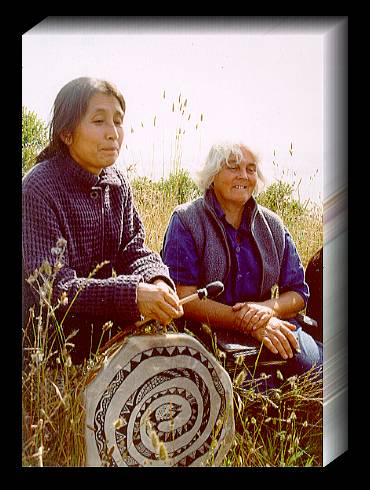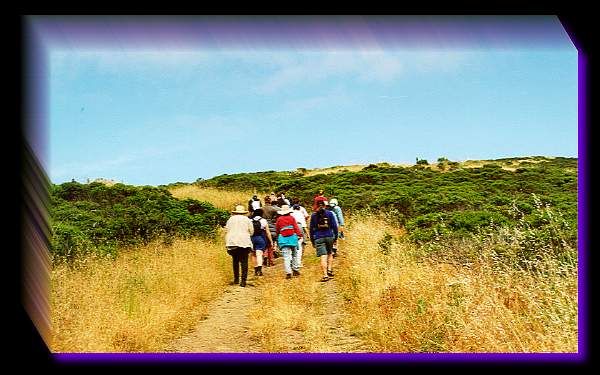
Meeting in the Garden:
Zen Consciousness and Environmental Activism
Story and Photos By Nina Wu
Listen, Shariputra, form is emptiness, emptiness is form, form does not differ from emptiness, emptiness does not differ from form. The same is true with feelings, perceptions, mental formations, and consciousness.
The excerpt above is from the Heart Sutra, regarded as the essence of Buddhist teachings and recited daily in temples throughout the world. It speaks of the interconnectedness of life, according to Thich Nhat Hanh, a well-known Zen Buddhist peace activist and monk. "Form does not differ from emptiness, emptiness does not differ from form" is akin to saying that "water is wave, wave is water" when "wave" represents form and "water" represents emptiness, according to Hanh. Every particle in life and every action will cause a reverberation throughout the universe, and is part of a larger whole.
When most people envision a Buddhist, they see a bare-headed monk seated on a cushion in the middle of a temple, chanting or meditating all day while trying to reach a state of nirvana. Or they think of Japanese Zen masters who spend their days raking tiny rock gardens, knowing the patterns they create will be destroyed the next day. Many people believe that to be Zen is to retreat and to let the material world slide by while developing the inner self. To be Zen is to practice letting go.
Yet a group of Bay Area Buddhists – mostly converts from other faiths – believe it is more than that. They believe in practicing "engaged Buddhism," which is about involvement. Certain members of the San Francisco Zen Center find that their Buddhist worldview binds them to social and environmental activism.
For Zen activist Wendy Johnson, the Buddhist philosophy is the inspirational force behind her work leading walks, practicing organic gardening and teaching. Every summer solstice, Johnson leads "Walk for the Earth," a meditative walk along the spine of the Marin headlands, where the Golden Gate Bridge peeks from behind the golden-green hills.
Walking, says Johnson, is about awareness. Moving to the beat of a Japanese drum, the participants walk in silence while Johnson has them contemplate the destruction to the world’s environment. A designated person both at the front and back rings a brass bell, a reminder of what the walk is for. Concerns range from nuclear weapons to beached whales, global warming and urbanization.
Johnson and Zen teacher Zoketsu Norman Fischer first began organizing the walks after the 1992 Earth Summit in Rio de Janeiro. "His Holiness (the Dalai Lama) called all Buddhists throughout the world to spend one day of the year really paying attention to the earth, walking or sitting, and having one day of meditation dedicated to awareness of the earth and the life of the earth," said Johnson. "We took that very seriously."
The first walk was conducted the following summer. Since then, a number of people have participated in the walks, which are free to the public and draw on average about 30 people. Most of them are newcomers. Johnson usually leads the walk with her neighbor Mayumi – a native Buddhist from Japan.
Chanting is also about awareness. During several points along the walk, Johnson stops to point out a particular spot or to pause for meditative chants such as the Kannon Gyo (chant for prolonging life) or the Heart Sutra (about the interconnectedness of all life).
Johnson uses the four directions to call forth the spirit of awareness in a prayer for the earth. At one vista point, Johnson gathers everyone in a circle. After some drumming and chanting, she invites everyone to face all four directions – north, east, south and west – to name or call out a particular person or concern that it evokes. Some people reach out across the hills towards the city, while others reach much farther, towards China, the Far East and South America.
"We’re often not oriented to where we live," Johnson said. "So plant your feet firmly in the ground; turn to the east, where the sun comes up; turn to the south, where the heat is great; turn to the west, where the sun goes down; turn to the north, where the wind comes up. What comes into your consciousness or being?"
Zen in Action
For Johnson, activism has always been part of life. Her father was a World War II pilot who later became a peace activist. He instilled the philosophy in all of his children. In 1971, Johnson ventured to Israel to work on a Kibbutz, where she met Japanese Zen teacher Soen Roshi and first became interested in Zen Buddhism.
Two years later, she went to Tassajara, San Francisco Zen Center’s mountain retreat, to immerse herself further in the studies of Buddhism. Now it is an integral part of her life’s work, and she engages herself in environmental activism through practicing organic gardening, as well as teaching it to children. "The main emphasis of Zen Buddhism is on meditation and studying the self," she said. But she also said it is through work with others that one learns about oneself. Thus, Zen Buddhism and activism go hand in hand.
During the summer, Johnson holds a series of lectures called Zen in Action: Practices for the Front Line. The seminar serves as a forum for Zen practices that sustain activism. Topics range from environmental activism to work with prisoners, which covers methods in teaching them to meditate.
One morning, at a "Community Gardens" seminar a dozen participants gathered in the Wheelwright Center to listen to how three activists initiated an organic community garden in one of San Francisco’s roughest neighborhoods. It is a success story, but one of hard work, persistence and sacrifice.
San Francisco teachers Sam McWilliams and Bridget Hughes helped bring the John Muir Community Learning Garden to life at Koshland Park. They had met a few years earlier while working as apprentices at Green Gulch Farm.
"For most of the kids it was exciting to go out," said McWilliams. "Digging is mentally stimulating. So they loved it. But there are some kids who hate it, because they don’t want to get dirty and they want to keep their sneakers clean. But then after a while, even they start holding a snail in the palm of their hands. They see themselves connected to that and it’s exciting."
The Garden as a Link
Gardening, says Johnson, is an active link to consciousness. "We feel very fortunate because we have the opportunity to eat the food that we grow, and that's really important in building awareness," Johnson said. She is currently working on a book about meditation and gardening for Bantam Press.
At Green Gulch, rows of organic beans, lettuce, cabbage, chard, broccoli, spinach, radishes and potatoes grow in the fields. Apprentices who live on the farm cultivate the fields and sell them at the Ferry Plaza Farmer’s Market in San Francisco on Saturday mornings. Near the entrance, there is also the Peace Garden, fragrant with apple trees, roses, chamomile and other blooms. Being there is a heady experience yet a spiritual one as well.
The four-mile "Walk for the Earth" ends in the Peace Garden, where participants relax on the benches and eat dessert. Johnson invites some to take home a head of butter lettuce from the garden. Soon she will uproot the lettuce to plant new seeds, which are donated to Green Gulch.
Several times a year, a busload of elementary school kids from Oakland and San Francisco visit the farm for a field trip. The kids who come to the farm discover a different world from the urban one they know. They find a place where they can throw down their backpacks, run around in open space, and climb a tree. For some, it is the first time seeing the ocean. Consciousness has the opportunity to grow.
"I know that (the garden’s) my place, and my calling," Johnson said. "My life’s work is directed toward the garden and children because I’m also the mother of a child. Gardens save lives; gardens are a way of being."
